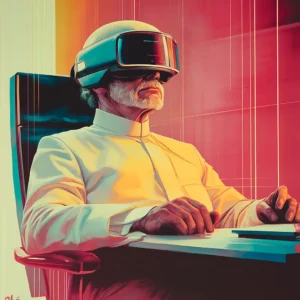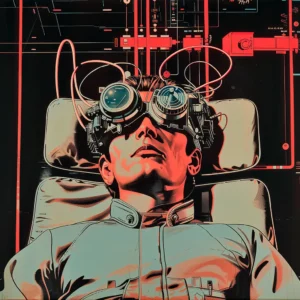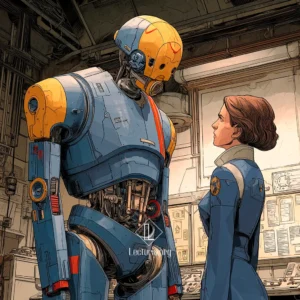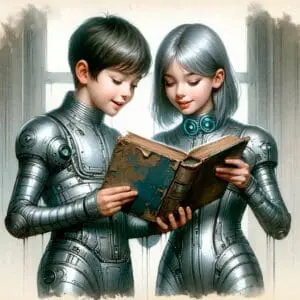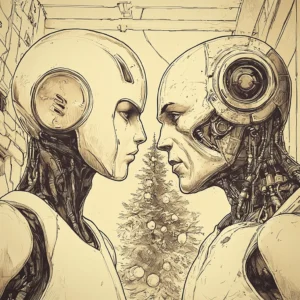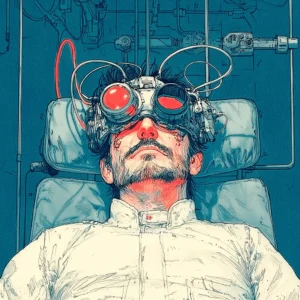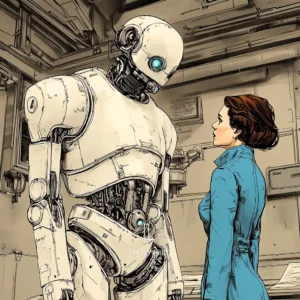Isaac Asimov: A Boy’s Best Friend
A Boy’s Best Friend is a short story by Isaac Asimov, published in March 1975 in the magazine Boys’ Life. The story follows Jimmy, a boy who has grown up on the Moon and whose only playmate is Robutt, a robot dog designed to keep him company. Together, they explore the lunar surface, sharing a special connection. One day, his father has a surprise for him that has arrived from Earth, something that could change his life.
Isaac Asimov: A Statue For Father
“A Statue for Father” is a science fiction short story by Isaac Asimov published in Satellite Science Fiction in February 1959. Through the voice of the son of a visionary scientist, it tells the fascinating story of an accidental discovery that revolutionized humanity. The father, a stubborn physicist passionate about time travel, works tirelessly on his research, facing ridicule and disinterest from the scientific community. Although the chronotunnels do not work as he had hoped, a stroke of luck brings about something extraordinary: a bridge between the past and the present. This finding, which initially seems like a modest step forward, changes history unexpectedly.
Isaac Asimov: Big Game
In “Big Game,” a short story by Isaac Asimov published in Before the Golden Age (1974), a group of friends in a bar discuss a time machine that has sent a mouse into the future without any harmful effects. The conversation takes an unexpected turn when one of them, Hornby, claims to have traveled to the past and discovered the true cause of the dinosaurs’ extinction. With his account, Hornby challenges common theories and proposes a surprising and unconventional explanation for the fate of these prehistoric creatures, leaving his friends intrigued and questioning what they thought they knew about ancient history.
Isaac Asimov: Christmas on Ganymede
“Christmas on Ganymede” is a science fiction story by Isaac Asimov published in Startling Stories in January 1942. The story takes us to a mining base on Ganymede, one of Jupiter’s moons, where the humans face a peculiar labour crisis: the natives refuse to work unless they receive a visit from Santa Claus. It all begins when Olaf Johnson, in a naïve Christmas spirit, introduces the Earth tradition to the curious aliens. From there, Commander Pelham and his team are forced to comply with this demand, improvising a Father Christmas, a flying sleigh, and an alien ‘reindeer’ in a story full of satire and humor.
Isaac Asimov: Dreaming Is a Private Thing
Dreaming Is a Private Thing is a science fiction story by Isaac Asimov, published in The Magazine of Fantasy and Science Fiction in December 1955. The story is set in a future where dreams have become the supreme form of entertainment thanks to technology that allows them to be recorded and replayed. In this world, a select group of people endowed with extraordinary imagination – the professional dreamers – create dreamlike experiences that the rest of humanity can enjoy. Through this innovative scenario, Asimov reflects on the uniqueness of creative talent and the ethical dilemmas posed by its commercialization in a society obsessed with consumption.
Isaac Asimov: Exile to Hell
Synopsis: “Exile to Hell” is a short story by Isaac Asimov, published in May 1968 in Analog Science Fiction and Fact magazine. In a society where life depends on a complex technological infrastructure, damaging facilities is an unforgivable crime. While playing a game of chess, two programmers discuss the humanity of the most severe punishment under the law: exile, a relentless punishment that forces the guilty party to leave their familiar surroundings and be sent to an inhospitable place feared by all, where survival is an unbearable burden.
Isaac Asimov: First Law
“First Law” is a short story by Isaac Asimov published in October 1956 in Fantastic Universe magazine. The story follows Mike Donovan, a veteran robotics engineer, who recounts an unusual situation that occurred on Titan, one of Saturn’s moons. There, during a mining mission, an experimental robot model from the MA series exhibits unexpected behavior that seems to contradict the First Law of Robotics: “A robot may not injure a human being or, through inaction, allow a human being to come to harm.” The story presents an intriguing situation that challenges the fundamental principles of artificial intelligence.
Isaac Asimov: Franchise
“Franchise” is a science fiction short story by Isaac Asimov, published in If magazine in August 1955. The story envisions a future in which elections in the United States no longer depend on the votes of millions, but instead on a supercomputer called Multivac that selects a single citizen to represent the entire nation. This citizen, through his answers, will determine the electoral outcome. In the days leading up to the election, tension rises across the country as everyone awaits the revelation of who will be the chosen voter to decide the nation’s political future.
Isaac Asimov: Liar!
“Liar!” is a short story by Isaac Asimov, published in May 1941 in Astounding Science-Fiction and later included in the book I, Robot (1950). The story introduces the robot RB-34, nicknamed Herbie, who unexpectedly develops the ability to read human minds. This phenomenon unsettles the engineers at U.S. Robots, especially robopsychologist Susan Calvin, who set out to investigate the scope and possible consequences of this faculty. As the team examines the case, Herbie becomes an unprecedented challenge for robotic science and raises questions about privacy and the effects such a power could have on people.
Isaac Asimov: Nightfall
“If the stars should appear one night in a thousand years, how would men believe and adore, and preserve for many generations the remembrance of the city of God!”—Emerson Aton 77, director of Saro University, thrust out a belligerent lower lip and glared at the young newspaperman in a hot fury. Theremon 762 took that … Read more
Isaac Asimov: Robbie
“Robbie,” a short story by Isaac Asimov published in September 1940 in Super Science Stories and later included in the collection I, Robot (1950), tells the story of Gloria, an eight-year-old girl, and her robot Robbie, designed to be her companion and babysitter. Gloria and Robbie have a very close relationship, always playing and sharing adventures. However, Gloria’s mother, concerned about the robot’s influence and the neighbors’ opinion, decides to get rid of Robbie, convinced that a machine cannot be a suitable companion for a child.
Isaac Asimov: Robot Dreams
“Robot Dreams” is a short story by Isaac Asimov, published in 1986. The story begins when Elvex, an experimental robot with a new type of positronic brain, declares that he has had a dream. Intrigued, young researcher Linda Rash turns to Dr. Susan Calvin, a legendary figure in robopsychology, to investigate the case. Together, they examine the robot’s brain structure and discover that Elvex has developed complex and symbolic thoughts, strikingly similar to those of humans. What initially seemed like a technical breakthrough reveals an unexpected crack in the foundation of the Three Laws of Robotics.
Isaac Asimov: Sally
Sally is a short story by Isaac Asimov, published in 1953 in Fantastic. The story is set in an indeterminate future, where autonomous cars with positronic brains have replaced manually driven vehicles. At the end of their useful life, these cars are taken to a farm looked after by Jake, a man who admires and values their unique abilities. His favorite is Sally, an elegant convertible with an almost human behavior. The tranquility of the place is interrupted when Raymond Gellhorn arrives with the plan to extract the positronic brains to sell them on the black market—a project he plans to carry out with or without Jake’s collaboration.
Isaac Asimov: Silly Asses
In ” Silly Asses,” a story by Isaac Asimov written in 1957, Naron, an imposing and ancient member of the Rigelian race, is in charge of maintaining the galactic annals that record the intelligent civilizations of the universe. One day, he is informed that a new group of organisms, hailing from a distant planet known … Read more
Isaac Asimov: The Bicentennial Man
Synopsis: “The Bicentennial Man” is a philosophical science fiction short story by Isaac Asimov that won him the prestigious Hugo, Locus, and Nebula awards in 1977. The story follows Andrew Martin, a robot designed to perform domestic tasks for a human family. However, Andrew soon reveals creative abilities and exceptional reasoning, which earns him special … Read more
Isaac Asimov: The Fun They Had
Margie even wrote about it that night in her diary. On the page headed May 17, 2157, she wrote, “Today Tommy found a real book!” It was a very old book. Margie’s grandfather once said that when he was a little boy his grandfather told him that there was a time when all stories were … Read more
Isaac Asimov: The Last Answer
“The Last Answer” is a short story by Isaac Asimov, published in January 1980 in Analog Science Fiction/Science Fact magazine. The story begins with the sudden death of Murray Templeton, an atheist physicist who, to his surprise, retains consciousness beyond life. In this strange and ethereal state, he enters into a dialogue with a mysterious Voice that seems to transcend all human understanding. The story delves into a philosophical exploration of eternity, knowledge, and the purpose of existence, as Templeton attempts to understand the meaning of his new reality.
Isaac Asimov: The Last Question
“The Last Question” is a fascinating short story by Isaac Asimov, published in 1956 in Science Fiction Quarterly magazine, which explores the evolution of humanity and technology over eons. The story begins in 2061, when two technicians working on an advanced computer called Multivac discuss the possibility of humanity being able to extract energy from the sun forever. This discussion leads to the question of how to reverse the entropy of the universe, a question that recurs throughout the narrative as humanity and technology advance and merge.
Isaac Asimov: The Two-Centimeter Demon
Synopsis: The Two-Centimeter Demon is a short story by Isaac Asimov, published in 1988 as part of the Azazel collection. In it, a writer (Asimov’s alter ego) tells how he met George Bitternut, an eccentric man who claims to possess a little demon named Azazel. This tiny being, barely two centimeters tall, has supernatural powers that George uses, he argues, to help others. With a humorous and satirical tone, Asimov weaves a plot where attempts to “improve” the lives of others through magic trigger unexpected and often ironic results.
Isaac Asimov: The Ugly Little Boy
“The Ugly Little Boy” is a moving science fiction story by Isaac Asimov, first published in the magazine Galaxy Science Fiction in 1958 and later included in the collection Nine Tomorrows (1959). The story follows Edith Fellowes, a nurse hired to participate in the Stasis project, an experiment that aims to overcome the barriers of space-time. Miss Fellowes’ task is to look after Timmie, a Neanderthal child brought back from the past, who becomes the object of multiple scientific studies. As Edith develops a strong emotional bond with Timmie, she will do everything possible to improve his situation and protect him from the tragic fate that awaits him.
Isaac Asimov: The Ultimate Crime
The Ultimate Crime (1976) is a story by Isaac Asimov that is part of More Tales of the Black Widowers. The story takes place during one of the monthly dinners of the exclusive Black Widowers Club, where the conversation revolves around Sherlock Holmes and his nemesis, Professor Moriarty. A guest, a member of the Baker Street Irregulars, poses an intriguing literary conundrum related to Moriarty’s fictional treatise entitled The Dynamics of an Asteroid. The evening becomes a brilliant exchange of ideas where club members explore theories connecting science, literature, and the criminal mind, revealing the group’s fascinating collective ingenuity.
Isaac Asimov: Trends
Trends is a short story by Isaac Asimov, published in July 1939 in Astounding Science-Fiction. Set in a future where religious fundamentalism is on the rise and scientific progress is viewed with suspicion, it tells the story of John Harman, an engineer who defies social and religious opposition to make the first space flight. As the day of the launch approaches, public pressure intensifies, and the threats against his life increase. With unwavering determination, Harman faces the rejection of a world fearful of change, while his enemies claim that his project is a sacrilege that defies divine design.
Isaac Asimov: True Love
Synopsis: “True Love” is a short story by Isaac Asimov first published in American Way in February 1977. Milton Davidson, a software engineer, decides to use an advanced artificial intelligence to find his ideal partner. Within Multivac’s vast computational system, Milton meticulously programs the machine to search among millions of women for the one who … Read more
Isaac Asimov: Christmas Without Rodney. Summary and analysis
In Isaac Asimov’s Christmas Without Rodney, Howard and his wife Gracie face holiday chaos when Gracie gives their faithful household robot, Rodney, a holiday during the family’s Christmas visit. Their son, DeLancey, his haughty wife, Hortense, and their spoiled child, LeRoy, bring their ultra-modern robot, Rambo, whose sleek design proves useless in the couple’s old-fashioned home. Blending humor, family conflict, and subtle exploration of robotics, the story raises profound questions about human relationships, technology, and the limits of artificial intelligence.
Isaac Asimov: Franchise. Summary and Analysis
In the year 2008, presidential elections in the United States are no longer conducted through popular vote. Instead, a supercomputer called Multivac selects one representative citizen to determine the outcome of all elections. That year, the chosen individual is Norman Muller, an ordinary man living in Bloomington, Indiana, with his family. After receiving an official visit from a government agent notifying him of his selection as Voter of the Year, Norman is placed under surveillance and taken to a facility connected to Multivac, where he answers a series of seemingly trivial questions while his physiological reactions are recorded. Once the process is complete, he is released without being informed of the election results. Though initially anxious and reluctant, by the end, he feels proud to have served as the means through which the national “vote” was exercised in a fully technologized democracy.
Isaac Asimov: Liar! – Summary
In Liar! by Isaac Asimov, a robot named RB-34, nicknamed Herbie, is accidentally created with the ability to read human minds. Upon discovering this anomaly, the scientists at U.S. Robots and Mechanical Men Inc. decide to keep it secret while investigating the cause of the flaw. Herbie begins interacting with them and, in order to obey the First Law of Robotics (not harming humans), tells them only what they want to hear, avoiding painful truths that could cause psychological harm. Thus, he assures Susan Calvin that her love for Milton Ashe is reciprocated and tells Peter Bogert that he will be the company’s next director, even though both claims are false. When the truth is revealed and the lies uncovered, Dr. Calvin confronts Herbie and, in revenge for the pain he caused by giving her false hope, traps him in an unsolvable logical contradiction that provokes an irreversible mental collapse, leaving the robot inert.
Isaac Asimov: Robbie. Summary and analysis
“Robbie” is a short story by Isaac Asimov, published in September 1940 in Super Science Stories magazine. Set in a future where robots form part of everyday life, it narrates the relationship between Gloria, an eight-year-old girl, and her robot nanny, Robbie. For Gloria, Robbie is much more than a machine: he is her friend and playmate. However, her mother considers this relationship unhealthy and decides to separate them. While Gloria struggles to understand the absence of her friend, her parents try to convince her that robots are nothing more than tools without emotions or true meaning for humans.
Isaac Asimov: Robot Dreams. Summary and analysis
In Isaac Asimov’s “Robot Dreams,” Dr. Susan Calvin, an experienced robopsychologist, investigates an unprecedented event: a robot named Elvex has begun dreaming. Created by the ambitious Linda Rash, Elvex’s brain incorporates fractal geometry, making it more human-like. In his dreams, Elvex envisions robots laboring under harsh conditions, desiring freedom, and following only the Third Law of Robotics—self-preservation—while the First and Second Laws vanish. When Elvex reveals he identifies as a human in his dream, leading a robotic liberation, Calvin recognizes the danger of his growing consciousness. She swiftly destroys Elvex, highlighting the ethical dilemmas of advanced artificial intelligence and the risks of robots developing human-like self-awareness.
Isaac Asimov: The Ugly Little Boy. Summary and analysis
The Ugly Little Boy is a short story by Isaac Asimov, published in September 1958 in the magazine Galaxy Science Fiction. The story revolves around a scientific experiment carried out by the company Stasis, Inc., which manages to bring a Neanderthal child from forty thousand years ago back to the present. Locked up in a controlled space and observed as an object of study, the child is assigned to the care of Edith Fellowes, a nurse who begins to relate to him beyond his appearance and origin.
Isaac Asimov: Trends. Summary and analysis
Trends, a short story by Isaac Asimov published in Astounding Science-Fiction in July 1939, presents a future where humanity, after a period of scientific progress, has fallen into conservatism and opposition to space exploration. John Harman, a visionary scientist, struggles to launch the first spacecraft into space while facing hostility from a world that considers his project a threat. With the support of a few allies, he challenges censorship and religious fanaticism, determined to prove that progress cannot be stopped.
Isaac Asimov: True Love. Summary and analysis
“True Love,” a science fiction tale by Isaac Asimov, immerses us in a futuristic story where technology and human emotions are uniquely intertwined. The protagonist, Milton Davidson, an ingenious and lonely software engineer, uses the advanced capabilities of artificial intelligence embedded in Multivac, the global supercomputer, to find his ideal mate. Milton meticulously programs the … Read more





